Engineering eHeritage—A New Approach for Study of Intangible Cultural Heritage. Case Study: The Analysis of the Noise Produced by the Dacian Dracon
Abstract
:1. Introduction
- Is 3D geometry of the objects sufficient to achieve the concept of eHeritage?
- What kind of elements should be added to this approach in order to extend the information on it?
- How can we add the mass, structure, and equilibrium of elements in the virtual environment? Can VRML (virtual reality modeling language) applications answer these questions? Can we extend the capabilities of VRML application software?
- What can be done with this new information to the geometric model? Can it demonstrate the functionality of the reconstructed objects and their characteristics?
2. Materials and Methods
2.1. Hierarchy of the Activities in eHeritage
2.2. Proposed Algorithm
- Identifying of the system/piece/artifact to be analyzed, and the motivation of the analysis. Comparison between the concepts of Heritage and eHeritage for tangible objects (reference will be made to all aspects of defining heritage: Materials, shape, textures, functioning).
- Inventory and classification of archaeological evidence and available information. All historical sources are to be considered: Parts of artifacts, inscriptions, legends, traditions, and connections with other elements, to be able to outline the profile of the studied element.
- Establish the 3D reconstruction method and creating the 3D model.
- Identification of the functionality of the artifact and the characteristics to be analyzed (mechanical resistance, mode of operation, technical characteristics, flow of fluids, produced noises, e.g., Dacian flag, musical objects, manufacturing technologies, (e.g., bell casting)). Establishing the analysis method (finite element method, FEM; multibody, MB; fluent, and creating mathematical model). This is a new approach, transforming the simple 3D surfaces in objects with own properties by extending the concept of virtual reconstruction by adding information on the composition and structure of rebuilt element, including physical and mechanical properties.
- Creating the model for analysis (e.g., materials and shapes—FEM, functional mechanism—ADAMS, Matlab blocks)
- Running the digital model and extracting data. Types of results obtained. Analysis of results and conclusions.
2.3. Examples of Engineering eHeritage
2.3.1. Author’s Research
2.3.2. Other Research Activities
2.3.3. Limitations of the Study
3. Case Study: Dacian Dracon
3.1. The First Step—Identify and Clarify the Problem
3.2. The Second Step—Inventory and Classification of Archaeological Evidence and Available Information
3.3. Step Three—Establish the 3D Reconstruction Method and Create the 3D Model—Virtual Model for Analysis Using FEM
3.4. Step Four—Identification of the Functionality of the Artifact and the Characteristics to be Analyzed
3.4.1. Human Perception of Sound
3.4.2. About the Position of the Tail
3.4.3. Theories of Noise Production
- Assumptions that take into account the functionality of the device (the noise emitted is strong enough and can propagate at a reasonable distance, can operate at a horse running speed or even lower);
- Assumptions that take into account the fabrication of the device (manufactured with existing technologies at that time, consistent with the historical evidence we already know, easy to handle, not too hard).
3.5. Step Five—Creating the Model for Analysis
3.6. Step Six—Running the Digital Model and Extracting Data
3.7. Results from FEM Analysis
3.8. Creating a Prototype Presentation Stand
3.8.1. Description of the Stand—Measuring the Intensity of the Sound on the Prototype
3.8.2. Results from Stand Analysis
4. Discussion and Conclusions
Funding
Conflicts of Interest
References
- Definition of Heritage. Available online: https://www.collinsdictionary.com/dictionary/english/heritage (accessed on 13 February 2019).
- UNESCO. Tangible Cultural Heritage. Available online: http://www.unesco.org/new/en/cairo/culture/tangible-cultural-heritage/ (accessed on 4 April 2019).
- UNESCO. Text of the Convention for the Safeguarding of the Intangible Cultural Heritage. Available online: https://ich.unesco.org/en/convention (accessed on 4 April 2019).
- Isa, W.M.W.; Zin, N.A.M.; Rosdi, F.; Sarim, H.M. Digital Preservation of Intangible Cultural Heritage. Indones. J. Electr. Eng. Comput. Sci. 2018, 12, 1373–1379. [Google Scholar] [CrossRef]
- Lin, Q.; Lian, Z. On Protection of Intangible Cultural Heritage in China from the Intellectual Property Rights Perspective. Sustainability 2018, 10, 4369. [Google Scholar] [CrossRef]
- Suárez, R.; Alonso, A.; Sendra, J.J. Archaeoacoustics of intangible cultural heritage: The sound of the Maior Ecclesia of Cluny. J. Cult. Herit. 2016, 19, 567–572. [Google Scholar] [CrossRef]
- European Communities. DigiCULT, Technological Landscapes for Tomorrow’s Cultural Economy, Unlocking the Value of Cultural Heritage: Full Report; Part of Library of Congress Online Catalog (978,398); Luxembourg, 2002. Available online: https://www.loc.gov/item/2005373383/ (accessed on 23 March 2019).
- Bruno, F.; Bruno, S.; De Sensi, G.; Luchi, M.-L.; Mancuso, S.; Muzzupappa, M. From 3D reconstruction to virtual reality: A complete methodology for digital archaeological exhibition. J. Cult. Herit. 2010, 11, 42–49. [Google Scholar] [CrossRef]
- Del Barrio, M.J.; Devesa, M.; Herrero, L.C.; Prieto, L.C.H. Evaluating intangible cultural heritage: The case of cultural festivals. City Cult. Soc. 2012, 3, 235–244. [Google Scholar] [CrossRef]
- Antonya, C.; Butnariu, S.; Gams, M. Haptic Interface Design for Experiencing Ancient Works. In Proceedings of the 19th International Multiconference on Information Society—IS 2016, Ljubljiana, Slovenia, 10–14 October 2016; pp. 16–19. [Google Scholar]
- Butnariu, S.; Duguleană, M.; Brondi, R.; Gîrbacia, F.; Postelnicu, C.C.; Carrozzino, M. An interactive haptic system for experiencing traditional archery. Acta Polytech. Hung. 2018, 15, 185–208. [Google Scholar] [CrossRef]
- Birliba, D.M. Sfintenia Cuvintelor Tiparite. Available online: http://ziarullumina.ro/sfintenia-cuvintelor-tiparite-114417.html (accessed on 10 November 2018).
- Butnariu, S.; Gîrbacia, F. High Quality 3D Restoration of Photographed Structures Using V.R. Technologies. Appl. Mech. Mater. 2014, 464, 391–398. [Google Scholar] [CrossRef]
- Butnariu, S.; Gîrbacia, F.; Orman, A. Methodology for 3D reconstruction of objects for teaching virtual restoration. Int. J. Comput. Sci. Res. Appl. 2013, 3, 16–21. [Google Scholar]
- Girbacia, F.; Butnariu, S.; Orman, A.; Postelnicu, C.C. Virtual restoration of deteriorated religious heritage objects using augmented reality technologies. Eur. J. Sci. Theol. 2013, 9, 223–231. [Google Scholar]
- Delatte, N. Lessons from Roman Cement and Concrete. J. Prof. Issues Eng. Educ. Pract. 2001, 127. [Google Scholar] [CrossRef]
- Brune, P.; Perucchio, R.; Ingraffea, A.R.; Jackson, M.D. The toughness of imperial roman concrete. In Proceedings of the 7th International Conference on Fracture Mechanics of Concrete and Concrete Structures, Jeju Island, Korea, 23–28 May 2010. [Google Scholar]
- Lo Dico, G.; Semilia, F.; Milioto, S.; Parisi, F.; Cavallaro, G.; Inguì, G.; Lazzara, G. Microemulsion Encapsulated into Halloysite Nanotubes and their Applications for Cleaning of a Marble Surface. Appl. Sci. 2018, 8, 1455. [Google Scholar] [CrossRef]
- Abbate, M.; D’Orazio, L. Water Diffusion through a Titanium Dioxide/Poly(Carbonate Urethane) Nanocomposite for Protecting Cultural Heritage: Interactions and Viscoelastic Behavior. Nanomaterials 2017, 7, 271. [Google Scholar] [CrossRef]
- Cavallaro, G.; Milioto, S.; Parisi, F.; Lazzara, G. Halloysite Nanotubes Loaded with Calcium Hydroxide: Alkaline Fillers for the Deacidification of Waterlogged Archeological Woods. ACS Appl. Mater. Interfaces 2018, 10, 27355–27364. [Google Scholar] [CrossRef]
- Zhao, G.; Zan, H.; Di, B.; Zhu, W.; Yu, Y. Research on Virtual Reconstruction Technology of Tujia Brocade Handcrafts. 3D Res. 2018, 9, 54. [Google Scholar] [CrossRef]
- Lang, Y.; Deng, X.; Zhang, K.; Wang, Y. Construction of Intangible Cultural Heritage Spot Based on AR Technology—Taking the Intangible Cultural Heritage of the Li Nationality in the Areca Valley as an Example. IOP Conf. Ser. Earth Environ. Sci. 2019, 234, 012119. [Google Scholar] [CrossRef]
- Zhang, Y.; Han, M.; Chen, W. The strategy of digital scenic area planning from the perspective of intangible cultural heritage protection. EURASIP J. Image Video Process. 2018. [Google Scholar] [CrossRef]
- Hajdin, M.; Kico, I.; Dolezal, M.; Chmelik, J.; Doulamis, A.; Liarokapis, F. Digitization and Visualization of Movements of Slovak Folk Dances. In The Challenges of the Digital Transformation in Education; ICL 2018, Advances in Intelligent Systems and Computing; Auer, M., Tsiatsos, T., Eds.; Springer: Cham, Switzerland, 2019; Volume 917. [Google Scholar]
- Vitorillo, J.; Arriola, M.S.M. Safeguarding intangible cultural heritage in the Philippines. In Routledge Handbook of Cultural and Creative Industries in Asia; Lim, L., Lee, H.-K., Eds.; Routledge: London, UK, 2018; pp. 372–382. [Google Scholar] [CrossRef]
- Furukawa, K.; Kojima, K.; Hachimura, K. Digital Renovation and Archives of Japanese Ancient Ritual Performance at the World Cultural Heritage; Niutsuhime Shrine. In Advances in Intelligent Systems and Computing, Proceedings of the 18th International Conference on Geometry and Graphics—ICGG 2018, Milan, Italy, 3–7 August 2018; Cocchiarella, L., Ed.; Springer: Cham, Switzerland, 2019; Volume 809. [Google Scholar]
- Dagnino, F.M.; Hadjileontiadis, L.J.; Ott, M.; Pozzi, F. An Integrated Platform Supporting Intangible Cultural Heritage Learning and Transmission: Definition of Requirements and Evaluation Criteria. J. Comput. Inf. Technol. 2014, 22, 277–292. [Google Scholar] [CrossRef]
- Dimitropoulos, K.; Tsalakanidou, F.; Nikolopoulos, S.; Kompatsiaris, I.; Grammalidis, N.; Manitsaris, S.; Denby, B.; Crevier-Buchman, L.; Dupont, S.; Charisis, V.; et al. A Multimodal Approach for the Safeguarding and Transmission of Intangible Cultural Heritage: The Case of i-Treasures. IEEE Intell. Syst. 2018, 33, 3–16. [Google Scholar] [CrossRef]
- Mortara, M.; Catalano, C.E.; Bellotti, F.; Fiucci, G.; Houry-Panchetti, M.; Petridis, P. Learning cultural heritage by serious games. J. Cult. Herit. 2014, 15, 318–325. [Google Scholar] [CrossRef]
- Yang, Y.; Zhang, D.; Ji, T.; Li, L.; He, Y. Designing Educational Games Based on Intangible Cultural Heritage for Rural Children: A Case Study on “Logic Huayao”. In AHFE 2018: Advances in Human Factors in Wearable Technologies and Game Design; Advances in Intelligent Systems and Computing; Ahram, T., Ed.; Springer: Cham, Switzerland, 2019; Volume 795. [Google Scholar]
- Scarre, C.; Lawson, G. Archaeoacoustics. McDonald Institute Monographs; McDonald Institute for Archaeological Research: Cambridge, UK, 2006. [Google Scholar]
- Till, R. Songs of the stones: The acoustics of Stonehenge. In The Sounds of Stonehenge; Banfield, S., Ed.; Archaeopress: Oxford, UK, 2009; pp. 17–39. [Google Scholar]
- The European Acoustic Heritage Project. Available online: http://europeanacousticheritage.eu/the-project/ (accessed on 4 March 2017).
- Avanzini, F.; Canazza, S.; de Poli, G.; Fantozzi, C.; Pretto, N.; Rodà, A.; Angelini, I.; Bettineschi, C.; Deotto, G.; Faresin, E.; et al. Archaeology and virtual acoustics. A pan flute from ancient Egypt. In Proceedings of the 12th International Conference on Sound and Music Computing (SMC-15), Maynooth, Ireland, 30 July–1 August 2015. [Google Scholar]
- Avanzo, S.; Barbera, R.; De Mattia, F.; La Rocca, G.; Sorrentino, M.; Vicinanza, D. Data sonification of volcano seismograms and Sound/Timbre reconstruction of ancient musical instruments with Grid infrastructures. Procedia Comput. Sci. 2010, 1, 397–406. [Google Scholar] [CrossRef]
- Sulaksna, K.; Thamatkeng, P. Heat Transfer & Fluid Flow Simulation with ANSYS (Tutorial); School of Mechanical Engineering, Suranaree University of Technology. Available online: http://eng.sut.ac.th/me/2014/document/training/CAETraining(Fluid).pdf (accessed on 20 January 2019).
- Roman Central Heating. Available online: https://www.romanobritain.org/12_innovations/inv_central_heating.php#.UqdIktJdVME (accessed on 20 January 2019).
- Draco. Available online: https://ro.wikipedia.org/wiki/Draco (accessed on 5 December 2017).
- Columna lui Traian, Roma. Available online: http://www.columnaluitraian.ro/ro/ (accessed on 25 November 2017).
- Trajan’s Column. Available online: https://www.nationalgeographic.com/trajan-column/ (accessed on 25 November 2017).
- Wheeler, E.L. The Occasion of Arrian’s Tactica; Duke University: Durham, NC, USA, 1978. [Google Scholar]
- Iliescu, V.; Popescu, V.C.; Stefan, G. (Eds.) Izvoare Privind Istoria Romaniei, Partea I; Academiei Romane: Bucharest, Romania, 1964. [Google Scholar]
- Dacian Draco—Dragonul Dacic. Available online: http://romaniamegalitica.blogspot.ro/2011/12/dacian-draco-dragonul-dacic.html (accessed on 4 February 2018).
- The Dacians. Available online: http://www.angelfire.com/realm/vlachs/ (accessed on 4 February 2018).
- Die Drachenstandarte von Niederbieber. Available online: http://www.deichstadtweg.de/kelten_und_roemer_in_neuwied_4.htm (accessed on 25 November 2017).
- Carnyx. Available online: https://en.wikipedia.org/wiki/Carnyx (accessed on 11 April 2018).
- Römische Soldaten in Ihrer “Freizeit”. Available online: http://augustusforum.de/forum/limesfest_in_rheinbrohl_11_und_12_mai_2013_teil_ii-6488803-t.html (accessed on 23 March 2019).
- Civilizatia Dacica—Festivalul Dacic Dac Fest Costesti. Available online: http://tudorphotoblog.blogspot.ro/2013/03/civilizatia-dacica-festivalul-dacic.html (accessed on 23 March 2019).
- Sound. Available online: https://en.wikipedia.org/wiki/Sound (accessed on 11 April 2018).
- Kurtus, R. Creating Sound Waves. Available online: http://www.school-for-champions.com/science/sound_creation.htm (accessed on 5 December 2017).
- Everything You Should Know about Sound. Available online: https://waitbutwhy.com/2016/03/sound.html (accessed on 5 December 2017).
- Windsock. Available online: http://kite-shop.ro/windsock (accessed on 26 November 2017).
- Windsock. Available online: https://en.wikipedia.org/wiki/Windsock (accessed on 26 November 2017).
- American Inventor, 7 March 2016. Available online: https://patentyogi.com/american-inventor/did-you-know-that-the-white-and-orange-strips-on-windsocks-are-not-for-decoration-they-actually-indicate-relative-wind-speeds/ (accessed on 26 November 2017).
- Taylor, P. How to Make a Draco (3)—The Noise. Available online: http://www.fectio.org.uk/articles/makedraco3.htm (accessed on 11 April 2018).
- Kite Musical Instruments & Aeolian Musical Instruments. Available online: http://www.windmusik.com/html/soundex.htm (accessed on 25 November 2017).
- Ffowcs-Williams, J.E.; Hawkings, D.L. Sound Generation by Turbulence and Surfaces in Arbitrary Motion. Proc. R. Soc. Lond. 1969, A264, 321–342. [Google Scholar]
- Chu, Y.-J.; Shin, Y.-S.; Lee, S.-Y. Aerodynamic Analysis and Noise-Reducing Design of an Outside Rear View Mirror. Appl. Sci. 2018, 8, 519. [Google Scholar] [CrossRef]
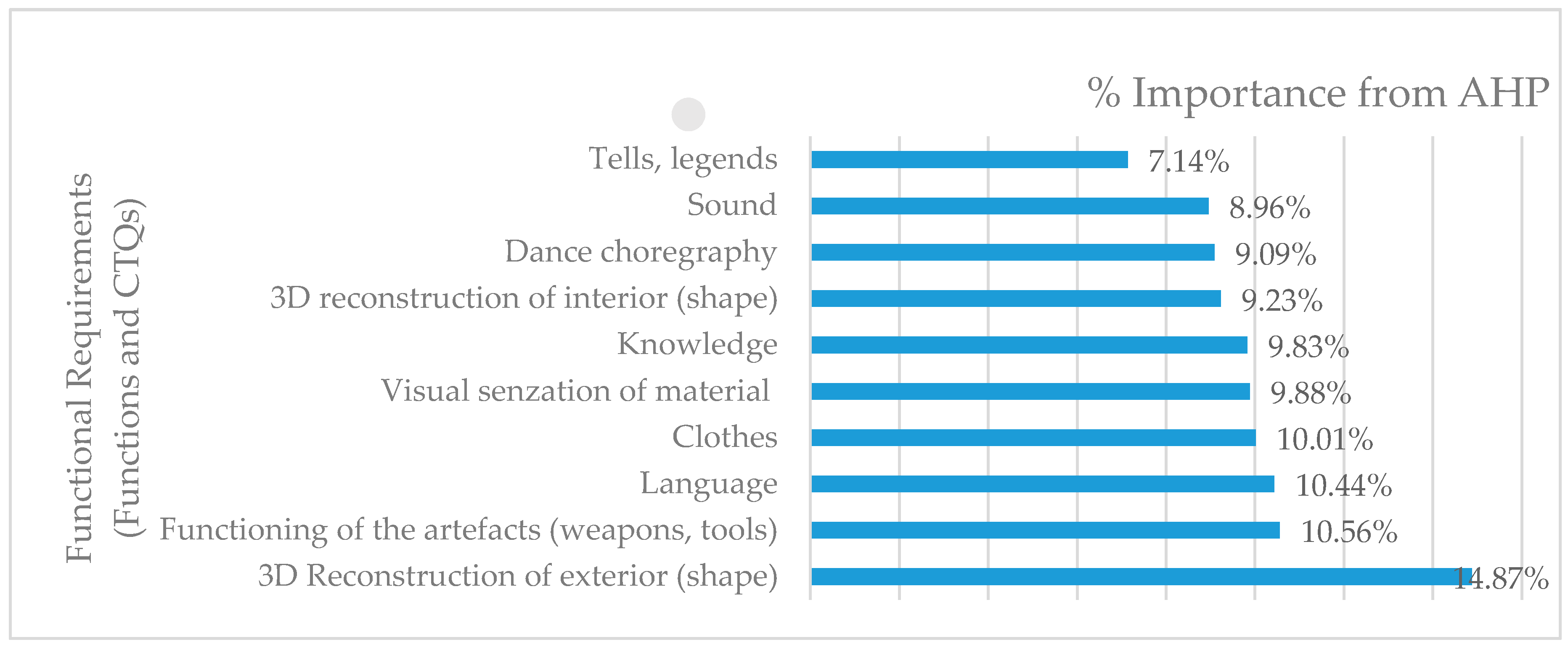

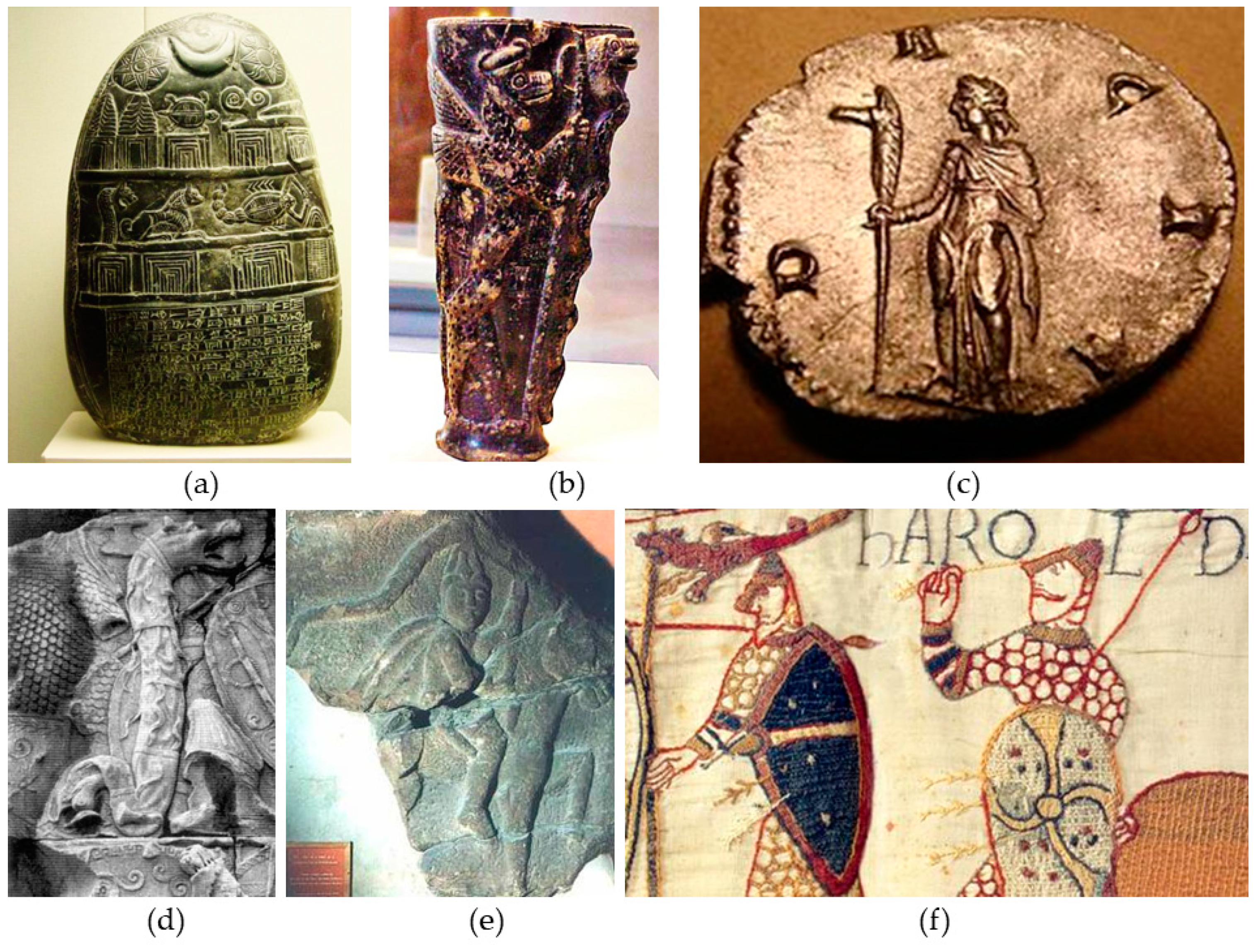

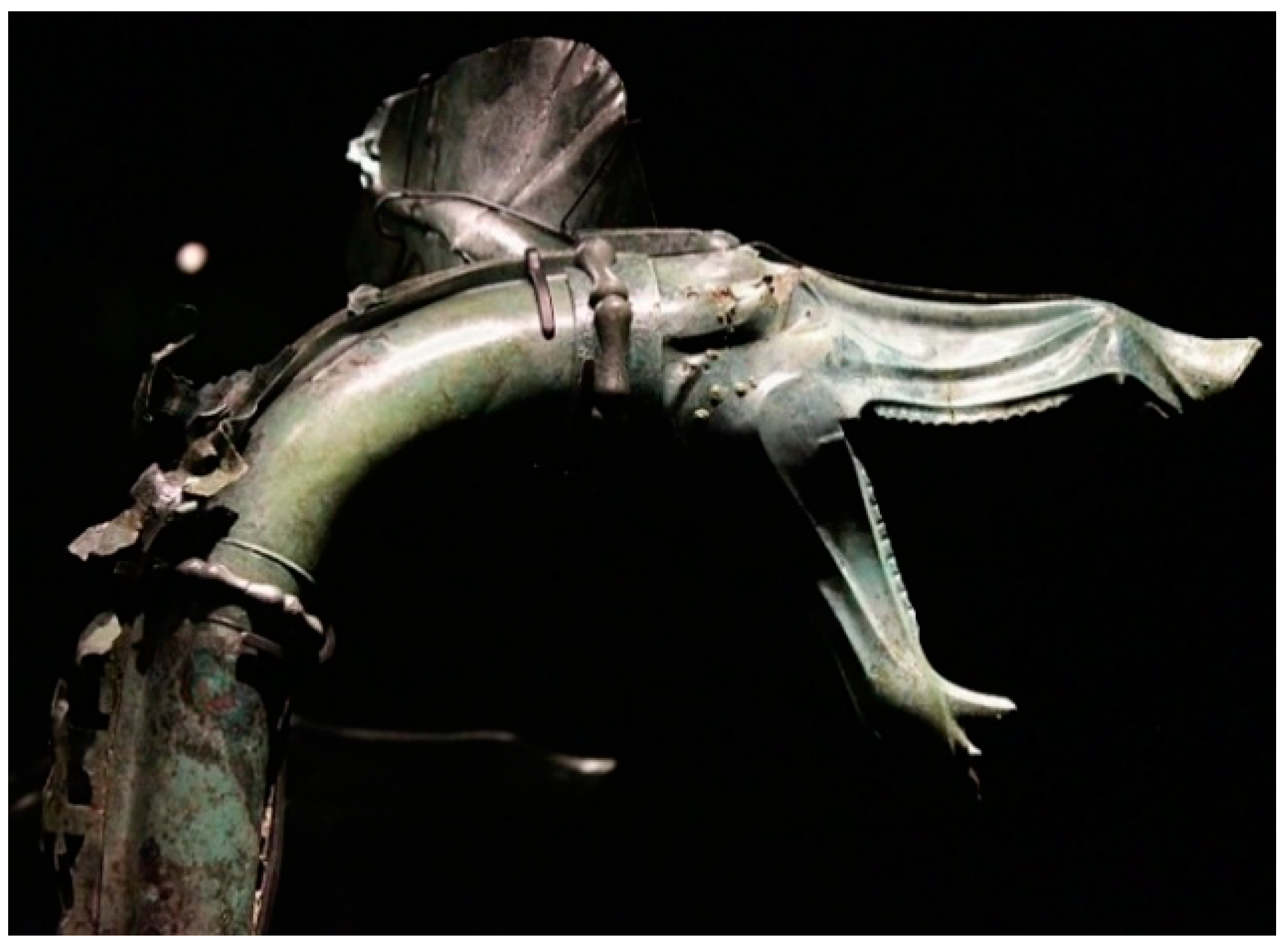

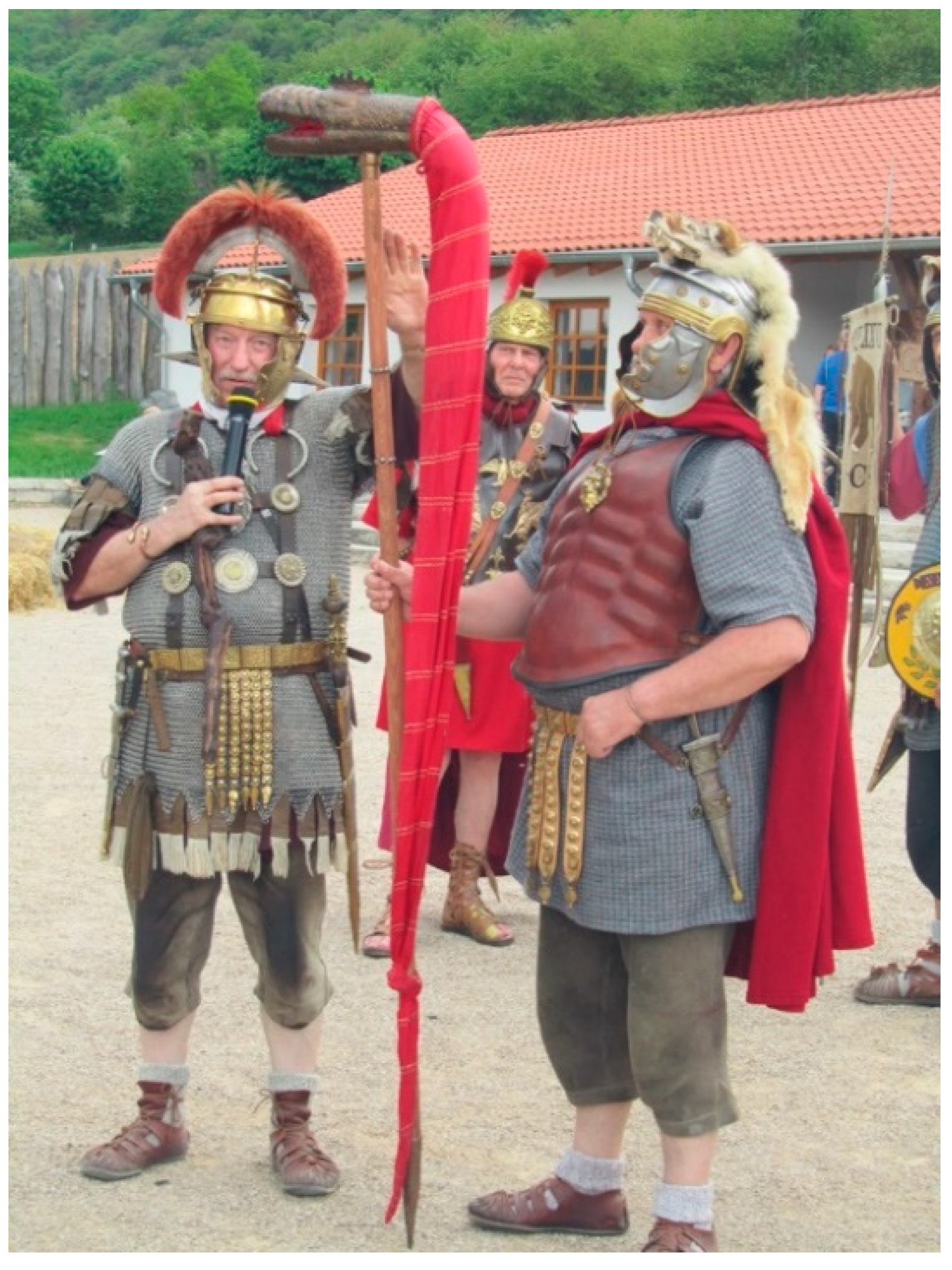
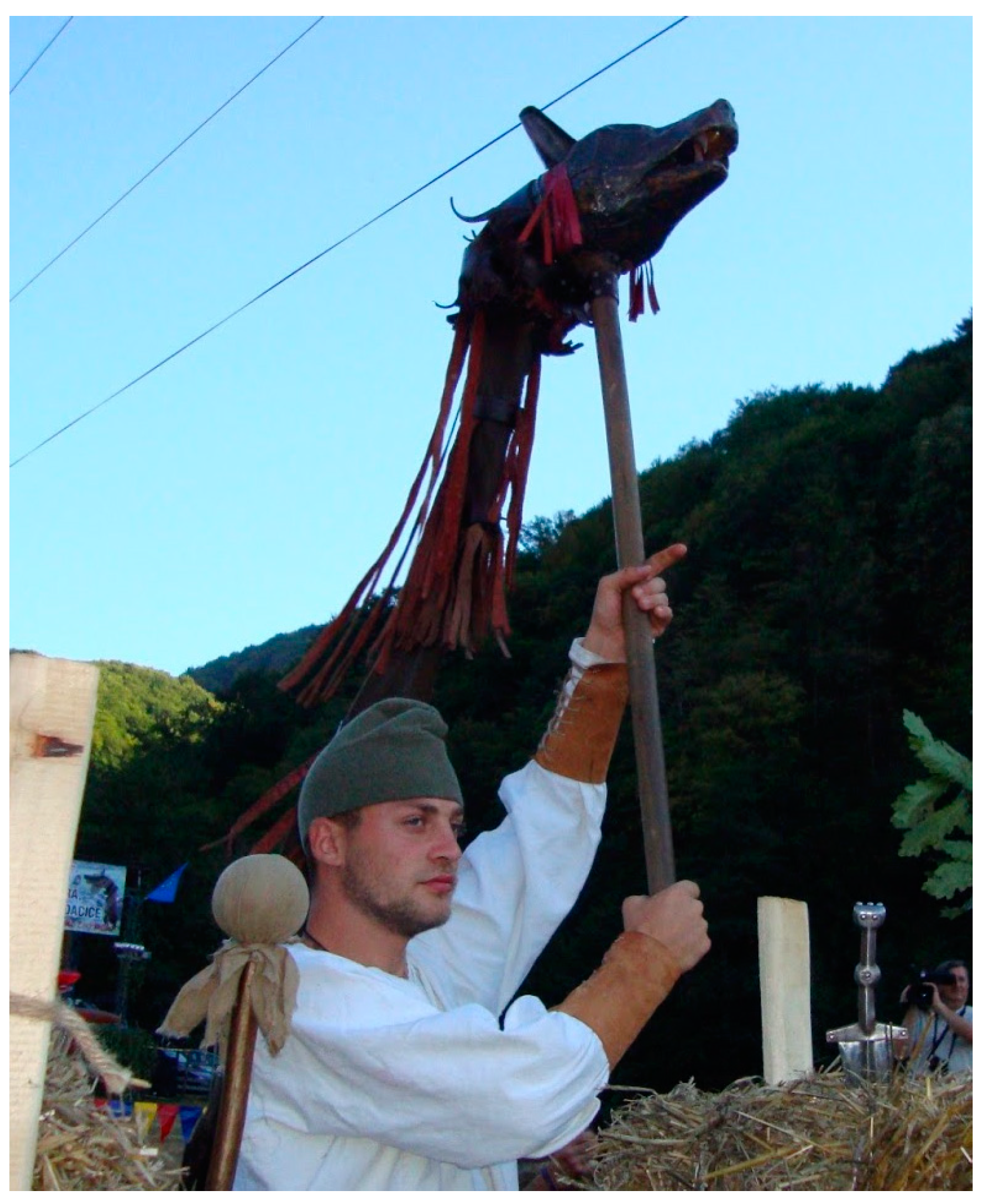
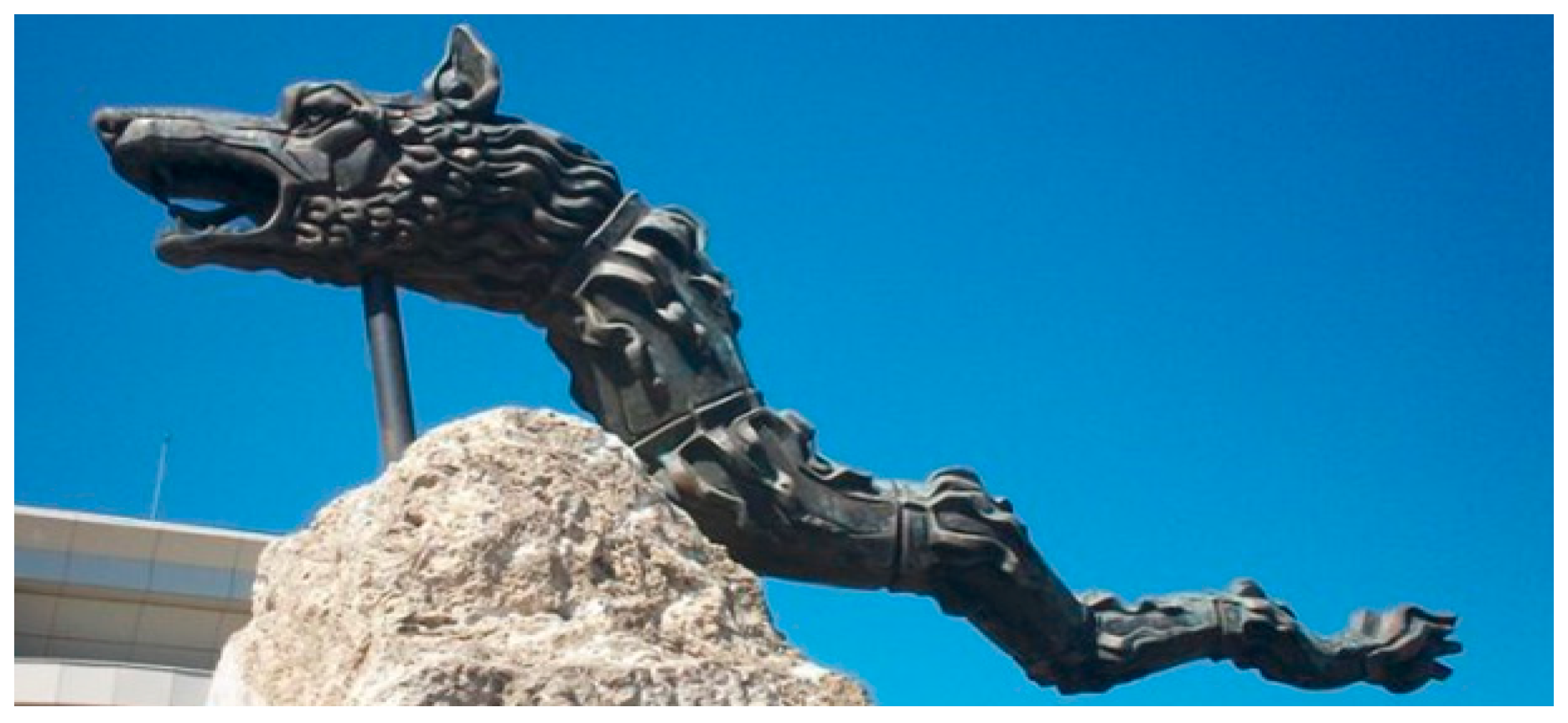
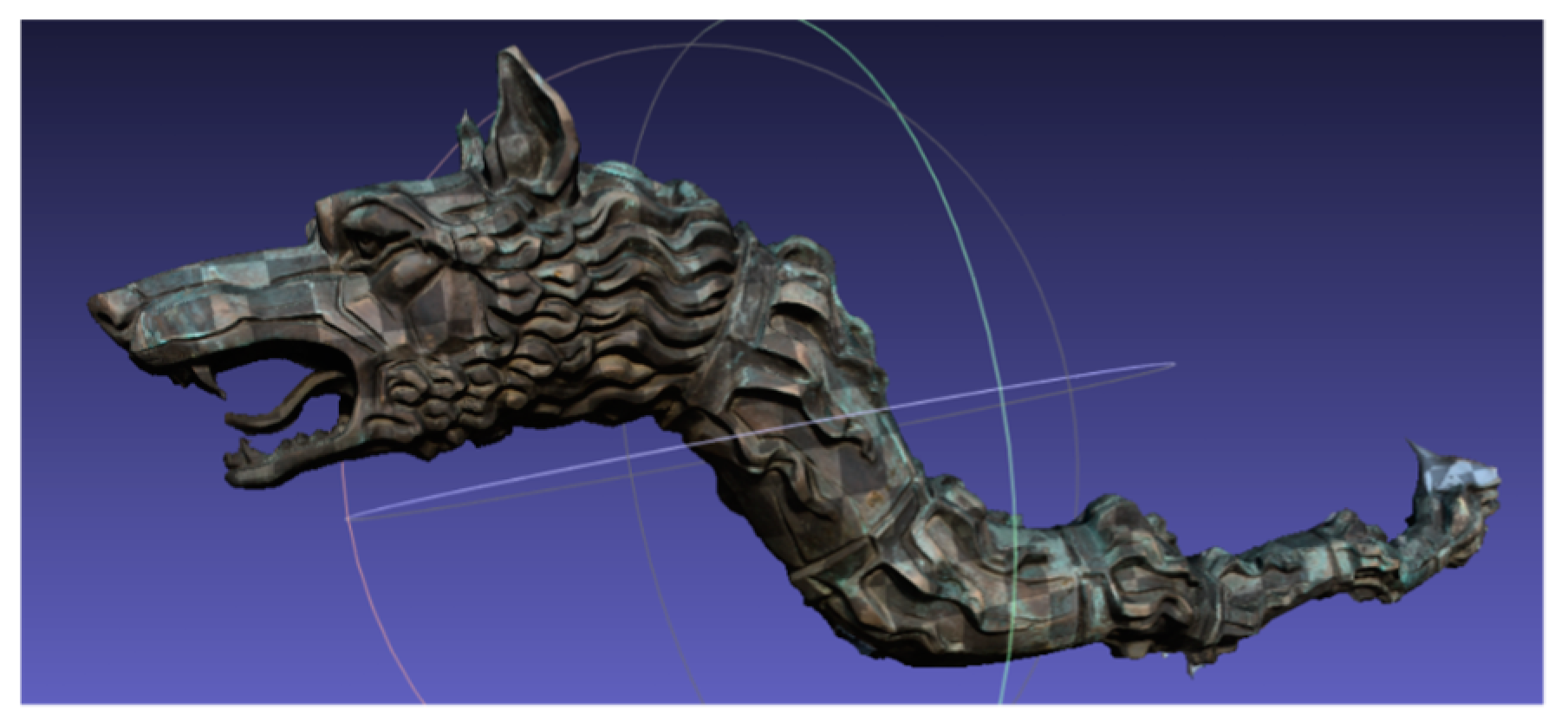



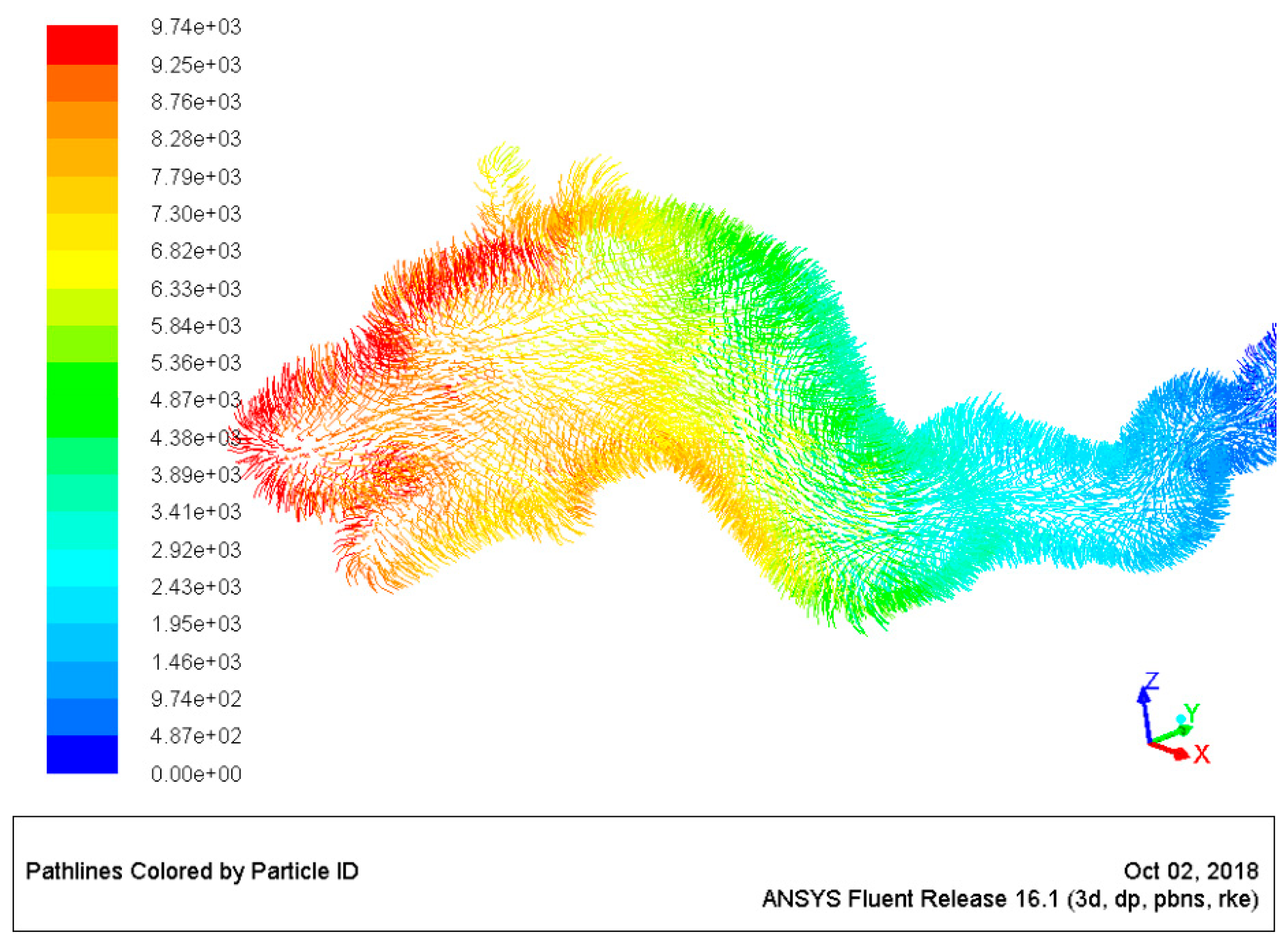
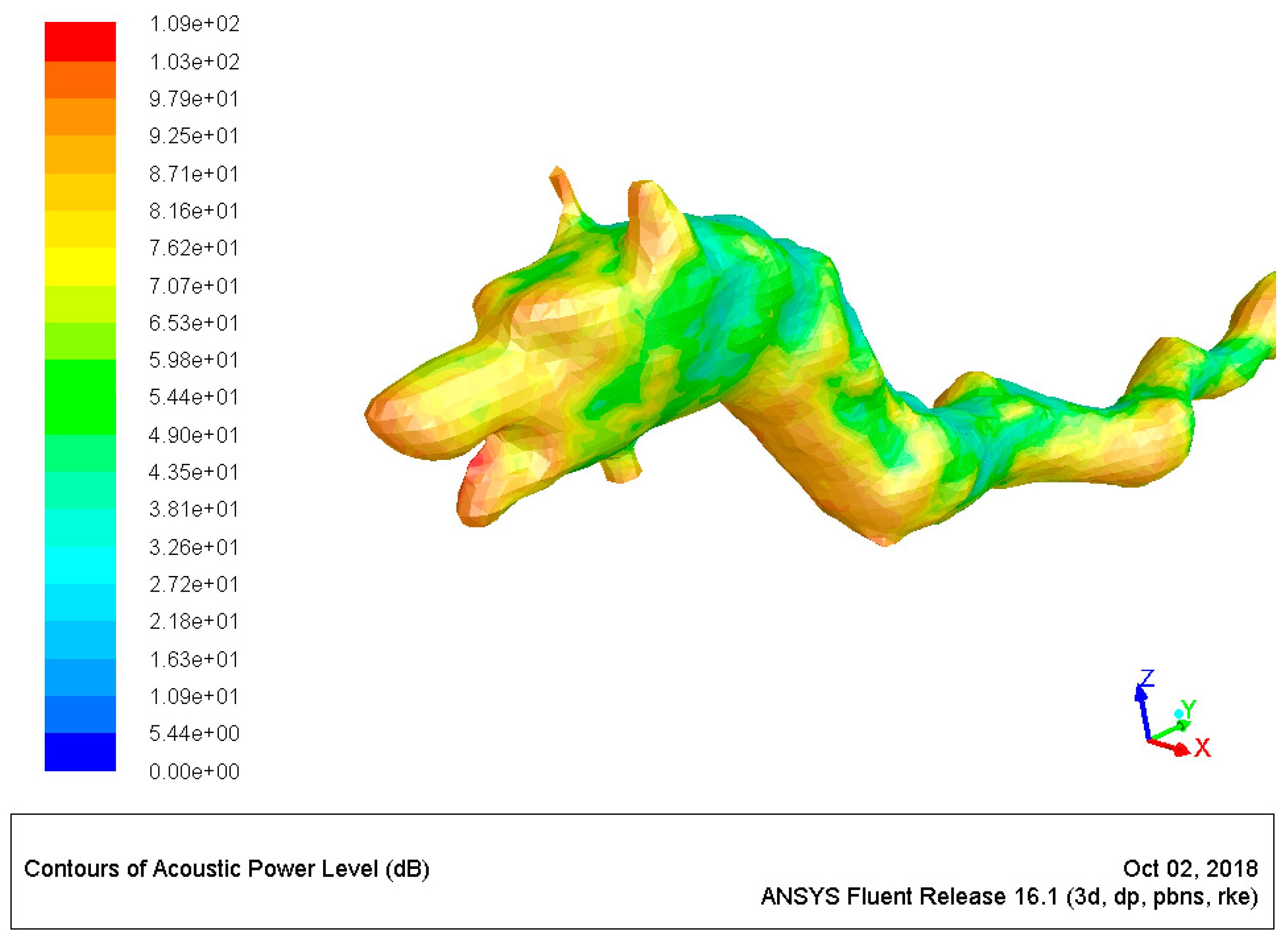
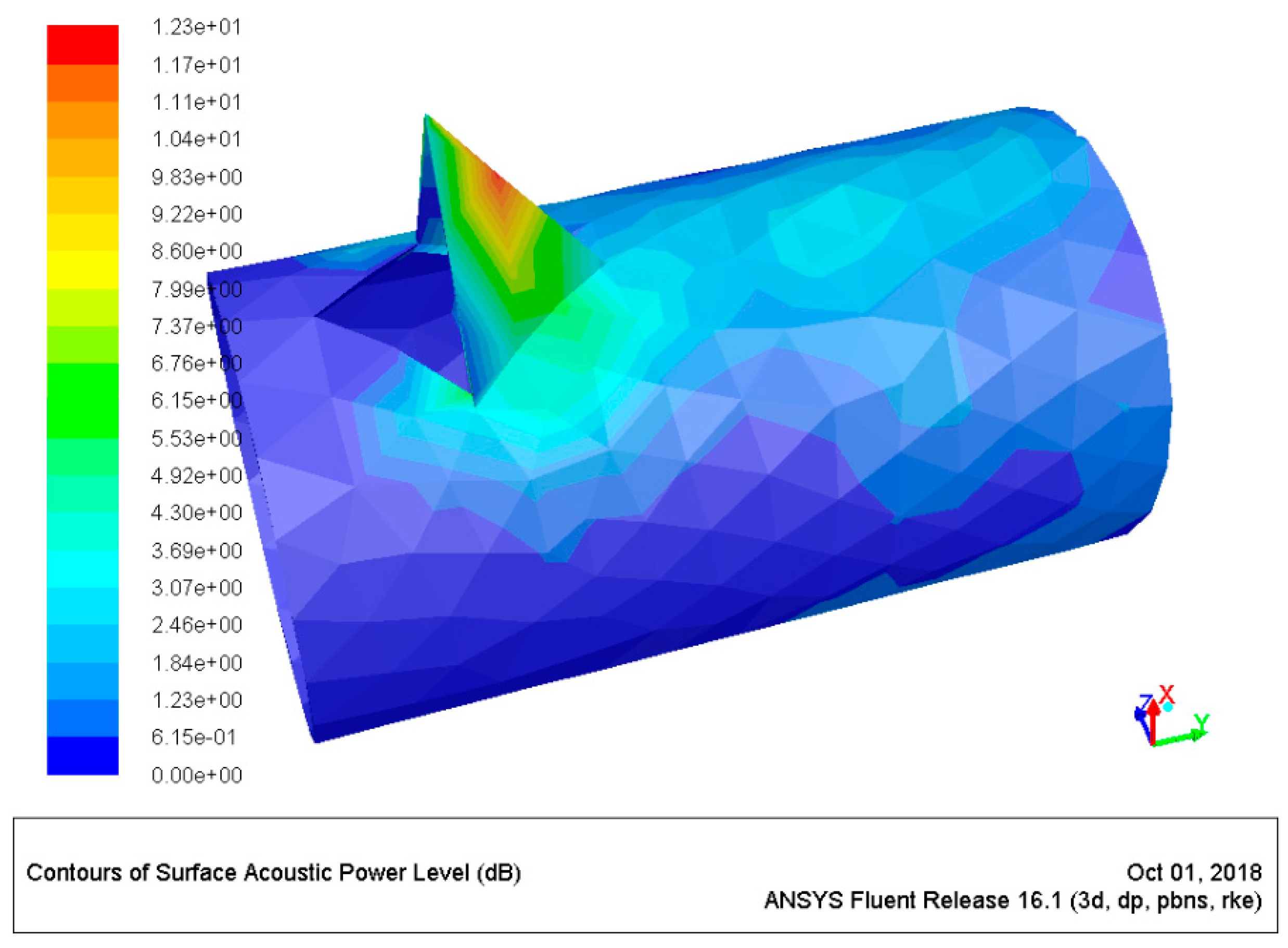
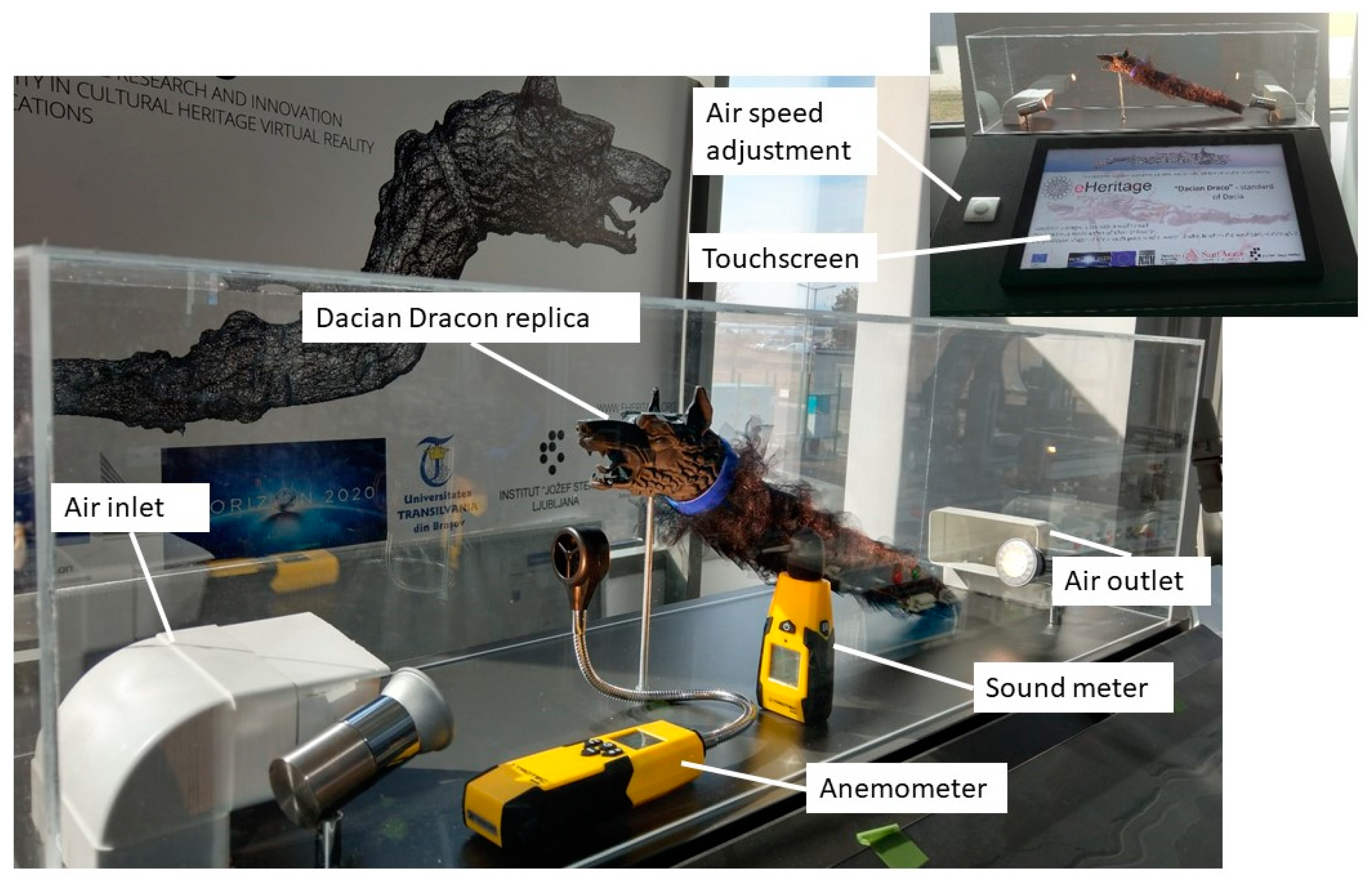
| Feeling | Sound/Noise Intensity | Description |
|---|---|---|
| Comfortable | 0–10 dB | Threshold of hearing |
| 10–20 dB | Faintest sounds we can hear | |
| 20–30 dB | Leaves rusting | |
| 30–60 dB | Quiet office | |
| Annoying | 60–70 dB | Normal conversation |
| 70–80 dB | Vacuum cleaner | |
| 80–85 dB | Garbage disposal | |
| Extremely Loud | 85–100 dB | Lawnmower, food blender |
| 100–110 dB | Motorcycle, jackhammer | |
| 110–120 dB | Car horn | |
| 120–125 dB | Loud rock concert | |
| Painful | 125–140 dB | Jet engine (30 m away) |
| Intolerable | 140–170 dB | Gun shot, Formula 1 race car |
| 170–194 dB | Grenade epicentre; Threshold of sound |
© 2019 by the author. Licensee MDPI, Basel, Switzerland. This article is an open access article distributed under the terms and conditions of the Creative Commons Attribution (CC BY) license (http://creativecommons.org/licenses/by/4.0/).
Share and Cite
Butnariu, S. Engineering eHeritage—A New Approach for Study of Intangible Cultural Heritage. Case Study: The Analysis of the Noise Produced by the Dacian Dracon. Sustainability 2019, 11, 2226. https://doi.org/10.3390/su11082226
Butnariu S. Engineering eHeritage—A New Approach for Study of Intangible Cultural Heritage. Case Study: The Analysis of the Noise Produced by the Dacian Dracon. Sustainability. 2019; 11(8):2226. https://doi.org/10.3390/su11082226
Chicago/Turabian StyleButnariu, Silviu. 2019. "Engineering eHeritage—A New Approach for Study of Intangible Cultural Heritage. Case Study: The Analysis of the Noise Produced by the Dacian Dracon" Sustainability 11, no. 8: 2226. https://doi.org/10.3390/su11082226
APA StyleButnariu, S. (2019). Engineering eHeritage—A New Approach for Study of Intangible Cultural Heritage. Case Study: The Analysis of the Noise Produced by the Dacian Dracon. Sustainability, 11(8), 2226. https://doi.org/10.3390/su11082226





